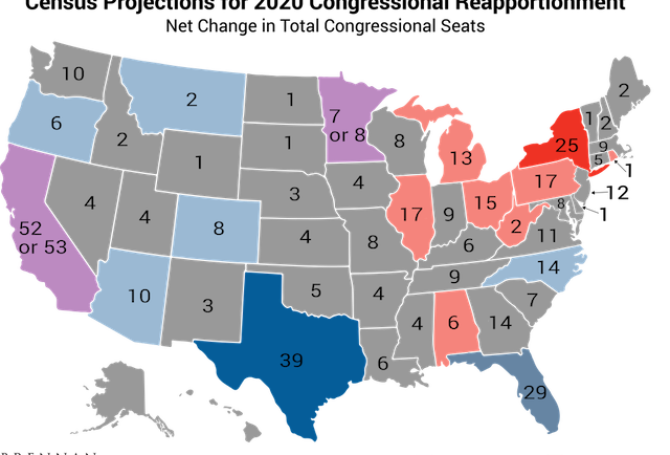
The 2020 election is over, but the 2022 election run-up has already begun. Election law changes are being proposed in Congress and key battleground states to expand or limit mail-in balloting. More significantly, 2020 US Census results have been delayed, which in turn is delaying reapportionment of US House seats and complicating state-level legislative and congressional redistricting.
What is shaping up is a tooth-and-nail battle over control of Congress, statehouses and state legislatures faced with a sharply divided electorate that is fed by divergent media outlets and fired up by very different leaders.
GOP-controlled legislatures in Georgia, Arizona and Pennsylvania are considering measures that roll back COVID provisions making it easier for voters to request and qualify for absentee ballots, a manifestation of Republican fears that Democrats will continue to dominate mail-in balloting as they did in the 2020 general election. It isn’t coincidental that those states gave their presidential electoral votes in 2020 to a Democrat.
Election observers note that older, conservative-leaning voters historically have tended to vote early and by mail. They may not have done so in 2020 because President Trump urged his supporters to vote in person. Democrats call the measures blatant efforts to suppress the vote in attempt to retain power.
Rolling back mail-in balloting may not be as easy as passing a state law. As Oregon discovered, mail-in voting amounts to vote-at-home convenience. That’s why Oregon Senator Ron Wyden and Congressman Earl Blumenauer reintroduced legislation titled the Vote at Home Act, which would authorize mail-in balloting nationally, provide voters with pre-paid return envelopes for ballots and enact automatic voter registration. Wyden and Blumenauer point out 30 states allowed mail-in voting in the 2020 election and 50 percent of the voters who cast ballots did so by mail.
Before the voting begins, however, House seats have to be reapportioned based on 2020 Census state-by-state data and legislative and congressional district maps have to be redrawn based on detailed, block-by-block population data. Census data was supposed to be delivered to the President in December, but was delayed in part because of the Trump administration’s unsuccessful efforts to skip counting noncitizens, despite wording in the Constitution requiring the count to include everyone.
Groups that follow the Census process project data to reapportion House seats for the 2022 election may not be available for a month or more. The data used for redistricting maps may not be fully accessible until summer.
Reapportionment could directly affect as many as 17 states, including Oregon which should pick up a sixth House seat. California is forecast to lose a House seat. Washington, which gained a seat after the 2010 Census, will remain the same. Overall, gains in Red States such as Arizona, Florida, North Carolina and Texas will come at the expense of losses in Blue states such as New York, Illinois, Michigan and Minnesota. One estimate says Red State gains could total at least five House seats, which happens to be the majority Democrats currently hold.
The gain or loss of a House seat in a state creates an opportunity or a political dilemma for congressional redistricting. Carving out a new district creates a chance for someone to win a congressional seat without defeating an incumbent. Collapsing districts means an incumbent will be without his or her district, posing the dilemma of retiring or trying to defeat a fellow incumbent. This can be a lot like relatives at Thanksgiving fighting over the last turkey leg.
While some redistricting maps are still hand-drawn sketches, modern technology allows more precise renderings based on computerized data sets, which come from the Census Bureau. The idea of reapportionment, which courts have validated, is to produce congressional districts with roughly the same population. There have been a number of court rulings, especially since the 1982 Voting Rights Act, that seek to prevent diluting minority voting power by spreading their votes over multiple districts.
The gain or loss of a House seat in a state creates an opportunity or a political dilemma for congressional redistricting. Carving out a new district creates a chance for someone to win a congressional seat without defeating an incumbent. Collapsing districts means an incumbent will be without his or her district, posing the dilemma of retiring or trying to defeat a fellow incumbent.
Gerrymandering has been and remains a fact of life in redistricting. Drawing lines to create Democratic- or Republican-leaning districts is constrained by court interpretations of the Equal Protection Clause in the Constitution, but that won’t stop most plans from perpetuating the political dominance of the party that draws the lines from one neighborhood to another.
And that’s the rub with the Census data delay. State lawmakers or, in some states redistricting commissions, won’t have the raw data to make the granular final decisions on district lines until well into the 2022 political season. Political squabbling, which is inevitable, can take time. Louisiana, Kentucky, Mississippi, New Jersey and Virginia will hold their state elections this fall. The scramble for Oregon’s new House seat will be intense, based on their best sense of where the power center of the new congressional district will lie.
Election law changes and slow-walked reapportionment and redistricting will have many politicians nervously looking over their shoulder. Political parties will try to rally their respective bases. Nothing promotes disunity more predictably than redistricting, which some political animals view as a blood sport.
So, while most Americans anxiously await the outcome of the 2020 election to unfold, they will be unavoidably – and perhaps even unwillingly – drawn into the emerging drama of the 2022 election, which, after all, is now less than two years away.




